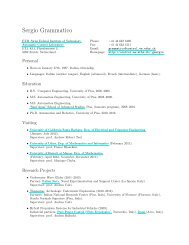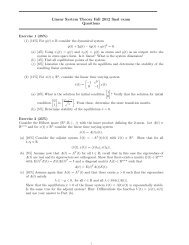Identification of deterministic piecewise affine models of genetic ...
Identification of deterministic piecewise affine models of genetic ...
Identification of deterministic piecewise affine models of genetic ...
Create successful ePaper yourself
Turn your PDF publications into a flip-book with our unique Google optimized e-Paper software.
<strong>Identification</strong> <strong>of</strong> <strong>deterministic</strong><br />
<strong>piecewise</strong> <strong>affine</strong> <strong>models</strong> <strong>of</strong> <strong>genetic</strong><br />
regulatory networks<br />
Giancarlo Ferrari-Trecate<br />
Dipartimento Dipartimento di di Informatica Informatica e e Sistemistica Sistemistica (DIS), (DIS),<br />
Universitàà Universit degli degli Studi Studi di di Pavia,, Pavia<br />
Italy Italy<br />
giancarlo.ferrari@unipv.it<br />
Thanks to: O. Bernard, D. Chieppi, S. Druhle, H. de Jong, R. Porreca<br />
HYGEIA PhD school on hybrid systems biology. July 20 th , 2007, Siena, Italy
Overview<br />
1. Basics on Genetic Regulatory Networks (GRNs) and their<br />
identification<br />
2. PieceWise Affine (PWA) <strong>models</strong> <strong>of</strong> GRNs<br />
3. Data-based reconstruction <strong>of</strong> GRNs<br />
• Pitfalls <strong>of</strong> general methods for PWA system identification<br />
• Towards gray-box identification <strong>of</strong> GRNs<br />
• Switch detection<br />
• Threshold reconstruction<br />
4. A case study: identification <strong>of</strong> E. coli carbon starvation response<br />
5. Conclusions<br />
HYGEIA PhD school on hybrid systems biology. July 20 th , 2007, Siena, Italy
Genetic regulatory networks<br />
GRNs underlie functioning and development <strong>of</strong> living organisms<br />
Components: genes, proteins, small molecules, and their mutual regulatory<br />
interactions<br />
Genes<br />
Activation<br />
Inhibition<br />
• Gene: dynamical system coding for a molecule (e.g. a protein)<br />
• Genes are regulated by the concentration <strong>of</strong> proteins present in the cell<br />
• Genes can be turned on and <strong>of</strong>f<br />
Fis<br />
fis<br />
HYGEIA PhD school on hybrid systems biology. July 20 th , 2007, Siena, Italy
Genetic regulatory networks<br />
GRNs underlie functioning and development <strong>of</strong> living organisms<br />
Components: genes, proteins, small molecules and their mutual regulatory<br />
interactions<br />
GRNs are usually large (many genes) and complex (feedback loops)<br />
GRN governing E. coli carbon starvation response<br />
Ropers et al.,<br />
BioSystems, 2006<br />
HYGEIA PhD school on hybrid systems biology. July 20 th , 2007, Siena, Italy
Gene expression data<br />
Experimental techniques in biology have led to the production <strong>of</strong><br />
enormous amount <strong>of</strong> data on the dynamics <strong>of</strong> gene expression:<br />
DNA microarrays<br />
gene reporter systems<br />
Time-series measurement <strong>of</strong><br />
fluorescence or luminescence<br />
rrn GFP<br />
HYGEIA PhD school on hybrid systems biology. July 20 th , 2007, Siena, Italy
Data-driven modeling <strong>of</strong> GRNs<br />
System identification problem: derive a model <strong>of</strong> the regulatory<br />
interactions according to measurements and model structure<br />
List <strong>of</strong>:<br />
• genes<br />
•proteins<br />
• small molecules<br />
Expression data<br />
rrn GFP<br />
List <strong>of</strong>:<br />
• <strong>genetic</strong> interactions<br />
• dynamical parameters<br />
Model structure<br />
(e.g. PWA)<br />
Gene reporter systems ⇒ adequate sampling time to capture GRN dynamics<br />
HYGEIA PhD school on hybrid systems biology. July 20 th , 2007, Siena, Italy
State <strong>of</strong> the art<br />
Classes <strong>of</strong> dynamical <strong>models</strong> that were used for modeling genes and<br />
GRNs:<br />
Linear (Gardner et al., Science 301, 2003)<br />
→ only valid near an equilibrium point<br />
Nonlinear smooth (Jaeger et al., Nature 430, 2004)<br />
→ more adequate description but difficult to use for identification<br />
PieceWise Affine (PWA)<br />
→ compromise between linear and non-linear<br />
Introduced by Glass and Kauffman in the 1970s<br />
de Jong et al., Bull. Math. Biol. 66, 2004<br />
Ghosh and Tomlin, Syst. Biol. 1, 2004<br />
Batt et al., HSCC05, Vol. 3414 <strong>of</strong> LNCS, 2005<br />
→ tools for analysis and abstractions available<br />
→ identification methods for PWA systems available<br />
HYGEIA PhD school on hybrid systems biology. July 20 th , 2007, Siena, Italy
PWA <strong>models</strong> <strong>of</strong> GRNs<br />
Consider a GRN composed by n genes<br />
• State vector:<br />
Toy example<br />
1<br />
1<br />
x =[x1,x2,...,xn] ∈ Ω<br />
2<br />
2<br />
gene product concentrations<br />
• State set Ω ⊂ R : hyperrectangle including the origin<br />
n ≥0<br />
protein<br />
activation<br />
inhibition<br />
gene<br />
max 1<br />
0<br />
HYGEIA PhD school on hybrid systems biology. July 20 th , 2007, Siena, Italy<br />
x 1<br />
Ω<br />
max 2<br />
x 2
GRN dynamics:<br />
fi(x) = P<br />
gi(x) = P<br />
l∈ ˜ Li ˜αil ˜ bil(x)<br />
Toy example<br />
1<br />
1<br />
PWA <strong>models</strong> <strong>of</strong> GRNs<br />
synthesis rate ≥ 0<br />
˙xi = fi(x) − gi(x)x, i =1,...,n<br />
l∈Li αilbil(x)<br />
2<br />
2<br />
degradation rate > 0<br />
0/1-valued polynomials <strong>of</strong> step functions<br />
s + (xj,θ) s − (xj,θ)<br />
1 1<br />
θ θ<br />
θ : switching threshold<br />
˙x1 = α11b11(x) − ˜α11x1<br />
˙x2 = α21b21(x) − ˜α21x2<br />
b11 = s − (x1, θ 1 1)s − (x2, θ 1 2)<br />
b21 = s − (x1, θ 2 1)s − (x2, θ 2 2)<br />
HYGEIA PhD school on hybrid systems biology. July 20 th , 2007, Siena, Italy
PWA <strong>models</strong> <strong>of</strong> GRNs<br />
• All thresholds split Ω into hyperrectangular domains {∆<br />
• Step functions are constant on each domain ⇒ PWA system<br />
j } s j=1<br />
•<br />
µ j = £ µ j<br />
1 ... µ j n<br />
˙x = µ j − ν j x if λ(x) =j<br />
¤T ≥ 0, ν j =diag(ν j<br />
1 ,...,νj n) > 0<br />
λ(x) =j ⇔ x ∈ ∆ j<br />
• : switching function<br />
Toy example<br />
max 2<br />
θ 2 2<br />
θ 1 2<br />
x 2<br />
∆ 1<br />
0 θ 1 1<br />
θ 2 1<br />
∆ 2<br />
max 2<br />
x 1<br />
· ˙x1<br />
˙x2<br />
⎧"<br />
¸ ⎪⎨<br />
=<br />
"<br />
⎪⎩ .<br />
α11<br />
α21<br />
α11<br />
0<br />
#<br />
#<br />
−<br />
−<br />
"<br />
"<br />
˜α11<br />
0 ˜α21<br />
HYGEIA PhD school on hybrid systems biology. July 20 th , 2007, Siena, Italy<br />
0<br />
0<br />
˜α11<br />
0 ˜α21<br />
#"<br />
#"<br />
x1<br />
x2<br />
x1<br />
x2<br />
#<br />
#<br />
, if λ(x) =1<br />
, if λ(x) =2
PWA model <strong>of</strong> a molecule concentration<br />
Dynamics <strong>of</strong> the i-th molecule concentration:<br />
{M j<br />
˙xi = κ j<br />
i<br />
− γj i xi if x ∈ M j<br />
i<br />
• i : molecule domains (regions in where the i-th<br />
concentration obeys to the same dynamics)<br />
•Inputs:<br />
}si<br />
j=1<br />
Ω<br />
xp, p6= i<br />
Toy example<br />
x 2<br />
max 2<br />
θ 2 2<br />
θ 2 1<br />
0<br />
M 1 1<br />
θ 1 2<br />
M 2 1<br />
θ 1 1<br />
max 2<br />
x 1<br />
Dynamics <strong>of</strong> x1:<br />
(<br />
α11 − ˜α11x1, if x ∈ M<br />
˙x1 =<br />
1 1<br />
−˜α11x1, if x ∈ M 2 1<br />
Standing assumption: no sliding-mode behaviors<br />
HYGEIA PhD school on hybrid systems biology. July 20 th , 2007, Siena, Italy
Data model<br />
Discrete-time model for the i-th molecule concentration:<br />
xi(k +1)=˜κ j<br />
i<br />
• ˜κ : rate parameters<br />
j<br />
i =(κji<br />
\γj i )(1 − e−γj i T ),˜γ j<br />
i = −eγj i T<br />
• T : sampling time<br />
• ηi, ξi : noise<br />
• yi(k) : measured data<br />
Common data <strong>models</strong>:<br />
yi(k) =xi(k)+ξi(k)<br />
− ˜γj i xi(k)+ηi(k) if x(k) ∈ M j<br />
i<br />
• PieceWise Autoregressive eXogenous (PWARX): ξi =0<br />
• PWA Output-Error (PWA-OE): ηi =0<br />
HYGEIA PhD school on hybrid systems biology. July 20 th , 2007, Siena, Italy
<strong>Identification</strong> <strong>of</strong> GRNs<br />
PWA discrete-time model <strong>of</strong> the GRN:<br />
xi(k +1)=˜κ j<br />
i<br />
yi(k) =xi(k)+ξi(k)<br />
i =1,...,n<br />
<strong>Identification</strong> problem: reconstruct<br />
• the number <strong>of</strong> modes<br />
• all rate parameters<br />
• all switching thresholds<br />
− ˜γj i xi(k)+ηi(k) if x(k) ∈ M j<br />
i<br />
from the dataset {yi(k),k =1,...,N,i=1:...,n}<br />
max 2<br />
Can one use available algorithms for the identification <strong>of</strong> PWA <strong>models</strong> ?<br />
θ 2 2<br />
θ 1 2<br />
HYGEIA PhD school on hybrid systems biology. July 20 th , 2007, Siena, Italy<br />
x 2<br />
0 θ 1 1<br />
θ 2 1<br />
max 2
Input-output PWA <strong>models</strong><br />
PWARX / PWA-OE <strong>models</strong> considered in hybrid identification:<br />
•<br />
u(k) MISO PWA w(k)<br />
system<br />
z(k +1)=φ j £ r(k) 0 1 ¤ 0 + η(k) if r(k) ∈ X j<br />
w(k) =z(k)+ξ(k)<br />
r(k) = £ z(k) ··· z(k − na) u(k) 0 ··· u(k − nb) 0 ¤ 0<br />
• {X :polyhedral partition <strong>of</strong> the polytope<br />
j } ˜s j=1<br />
PWA <strong>models</strong> for a single molecule<br />
concentration fall within this class<br />
X<br />
X 1 X 2<br />
X 3<br />
HYGEIA PhD school on hybrid systems biology. July 20 th , 2007, Siena, Italy<br />
X
<strong>Identification</strong> <strong>of</strong> I/O PWA <strong>models</strong><br />
PWARX / PWA-OE <strong>models</strong> considered in hybrid identification:<br />
z(k +1)=φ j £ r(k) 0 1 ¤ 0 + η(k) if r(k) ∈ X j<br />
w(k) =z(k)+ξ(k)<br />
Data set = noisy samples<br />
N = {(r(k),w(k))}<br />
Common assumptions:<br />
N k=1<br />
1. known model orders<br />
2. known regressor set<br />
PWARX system identification:<br />
X<br />
(Bemporad et al., 2005), (Vidal et al., 2005),<br />
(Juloski et al., 2005), (Ferrari-Trecate et al., 2003),<br />
...<br />
S<strong>of</strong>tware: Hybrid <strong>Identification</strong> Toolbox<br />
Estimate:<br />
1. the number ˜s <strong>of</strong> modes<br />
2. the parameters<br />
3. the regions {X j } ˜s {φ<br />
j=1<br />
j } ˜s j=1<br />
PWA-OE system identification:<br />
(Juloski & Weiland, 2006), (Rosenqvist & Karlström, 2006)<br />
HYGEIA PhD school on hybrid systems biology. July 20 th , 2007, Siena, Italy
Pitfalls <strong>of</strong> available methods<br />
Existing identification methods are generic in nature and do not<br />
exploit features <strong>of</strong> PWA <strong>models</strong> <strong>of</strong> GRNs<br />
Example 1: Switch detection from noisy measurements<br />
• Very challenging problem for general PWARX / PWA-OE <strong>models</strong><br />
• Much easier for PWA <strong>models</strong> <strong>of</strong> GRNs<br />
HYGEIA PhD school on hybrid systems biology. July 20 th , 2007, Siena, Italy
Pitfalls <strong>of</strong> available methods<br />
Example 2: switching thresholds ⇒ hyperrectangular domains<br />
x 2<br />
max 2<br />
θ 2 2<br />
θ 2 1<br />
0<br />
Existing identification methods do not take into account<br />
constraints <strong>of</strong> PWA <strong>models</strong> <strong>of</strong> GRNs<br />
∆ 7 ∆ 8 ∆ 9<br />
∆ 4 ∆ 5 ∆ 6<br />
∆ 1 ∆ 2 ∆ 3<br />
θ 1 2<br />
Neglecting this kind <strong>of</strong> information ...<br />
True domains Identified domains<br />
θ 1 1<br />
x 1<br />
max 1<br />
x 2<br />
max 2<br />
0<br />
X 7<br />
X 8<br />
X 4 X 5<br />
1 X2 X<br />
X 9<br />
X 6<br />
X 3<br />
HYGEIA PhD school on hybrid systems biology. July 20 th , 2007, Siena, Italy<br />
x 1<br />
max 1<br />
The concept <strong>of</strong> threshold associated to a concentration variable is lost
Pitfalls <strong>of</strong> available methods<br />
Existing hybrid identification methods produce a single result but data<br />
are <strong>of</strong>ten scarce and multiple <strong>models</strong> might be plausible<br />
Example: expression data in<br />
three domains<br />
Problem: find thresholds<br />
separating domains<br />
Three “minimal”<br />
combinations <strong>of</strong><br />
thresholds<br />
All <strong>of</strong> them should<br />
be produced !<br />
HYGEIA PhD school on hybrid systems biology. July 20 th , 2007, Siena, Italy
<strong>Identification</strong> <strong>of</strong> PWA <strong>models</strong> <strong>of</strong> GRNs<br />
Our approach: gray-box identification<br />
1) Detection <strong>of</strong> switches in gene expression data<br />
2) Estimation <strong>of</strong> the number <strong>of</strong> modes and attribution <strong>of</strong> the<br />
measurements to mode data sets<br />
3) Reconstruction <strong>of</strong><br />
• thresholds on concentration variables<br />
• all “minimal” combinations <strong>of</strong> thresholds consistent with<br />
the data<br />
4) Estimation <strong>of</strong> kinetic parameters for all <strong>models</strong> generated in point 3<br />
• Step 2 is currently under study<br />
• Step 4 is easy (LS on each mode data set)<br />
Next:<br />
• two algorithms for step 1<br />
• a procedure for step 3<br />
HYGEIA PhD school on hybrid systems biology. July 20 th , 2007, Siena, Italy
Switching index<br />
PWA-OE model for the i-th molecule:<br />
• {M : molecule domains<br />
j } s j=1<br />
Switching index:<br />
x(k +1)=˜κ j − ˜γ j x(k) if x(k) ∈ M j<br />
The indexemphasizesswitches:<br />
(Porreca et al., 2006)<br />
y(k) =x(k)+ξ(k), ξ(k) ∼ WGN(0, σ 2 n)<br />
if x(k − 1), x(k), x(k +1) belong to the same molecule domain<br />
for k = ka,...,kb , then o(k) is constant<br />
otherwise, it has a varying pr<strong>of</strong>ile<br />
HYGEIA PhD school on hybrid systems biology. July 20 th , 2007, Siena, Italy
Behavior <strong>of</strong> the switching index<br />
HYGEIA PhD school on hybrid systems biology. July 20 th , 2007, Siena, Italy
Moving Average (MA) switching indexes<br />
¯x(k+1)−¯x(k)<br />
ō(k) = ¯x(k)−¯x(k−1)<br />
= x(k+W )−x(k)<br />
x(k+W −1)−x(k−1)<br />
MA window<br />
¯x(k) = 1<br />
W −2<br />
P W −2<br />
i=1<br />
x(k + i)<br />
HYGEIA PhD school on hybrid systems biology. July 20 th , 2007, Siena, Italy
Data-based MA switching index:<br />
Data-based indexes<br />
Ratio <strong>of</strong> two Gaussian random variables<br />
Modified Cauchy distribution<br />
undefined mean and variance<br />
Fieller’s theorem allows one to compute the α-level<br />
confidence sets<br />
for ˜ō(k)<br />
in closed form<br />
The higher W the smaller confidence sets<br />
HYGEIA PhD school on hybrid systems biology. July 20 th , 2007, Siena, Italy
Data-based indexes<br />
HYGEIA PhD school on hybrid systems biology. July 20 th , 2007, Siena, Italy
Switch detection algorithm<br />
Key idea: aggregation rule based on confidence sets computed<br />
on different MA windows<br />
Aggregation<br />
confidence<br />
sets<br />
Aggregated<br />
ō<br />
ō<br />
HYGEIA PhD school on hybrid systems biology. July 20 th , 2007, Siena, Italy
Switch detection algorithm<br />
Key idea: aggregation rule based on confidence sets computed<br />
on different MA windows<br />
Aggregation Switch detection<br />
confidence<br />
sets<br />
Aggregated<br />
ō<br />
Further features <strong>of</strong> the complete algorithm<br />
ō<br />
confidence<br />
sets<br />
Aggregated<br />
re-inizialization after the detection <strong>of</strong> a switch<br />
backtracking for improving switch detection<br />
ad hoc handling <strong>of</strong> confidence sets <strong>of</strong> infinite length<br />
HYGEIA PhD school on hybrid systems biology. July 20 th , 2007, Siena, Italy<br />
ō<br />
(Porreca et al., 2006)<br />
ō
Switch detection based on nonlinear estimation<br />
Exponential model <strong>of</strong> the data (j-th mode):<br />
y(k) = κj<br />
µ <br />
j κ<br />
− − x(k0) e<br />
γj γj −γj (k−k0)T<br />
+ ξ(k)<br />
Switch detection strategy:<br />
estimate ˆκ using aggregated measures up to the time<br />
j , ˆγ j , ˆx(k0)<br />
hypothesis test:<br />
H 0 : belongs to the same mode;<br />
Iα α<br />
: -level confidence interval for under H 0 ,<br />
switch detection rule:<br />
y(kP +1)6∈ Iα<br />
HYGEIA PhD school on hybrid systems biology. July 20 th , 2007, Siena, Italy
Comparison <strong>of</strong> the methods<br />
Results based on<br />
extensive simumlations<br />
10 -5<br />
10 -4<br />
10 -3<br />
10 -2<br />
switching indexes<br />
accuracy<br />
fragmentation<br />
accuracy<br />
fragmentation<br />
accuracy<br />
fragmentation<br />
accuracy<br />
fragmentation<br />
97,1%<br />
4,4%<br />
93,8%<br />
5,2%<br />
69,7%<br />
16,4%<br />
22,3%<br />
34,3%<br />
Classification accuracy<br />
Molecule domain fragmentation<br />
nonlinear estimation<br />
accuracy<br />
fragmentation<br />
accuracy<br />
fragmentation<br />
accuracy<br />
fragmentation<br />
accuracy<br />
fragmentation<br />
75,3%<br />
34,4%<br />
80,7%<br />
26,9%<br />
69,7%<br />
30,7%<br />
63,8%<br />
15,2%<br />
HYGEIA PhD school on hybrid systems biology. July 20 th , 2007, Siena, Italy
Reconstruction <strong>of</strong> switching thresholds<br />
Assume that in early stages <strong>of</strong> identification:<br />
• the number <strong>of</strong> modes has been estimated<br />
• data have been attributed to modes <strong>of</strong> operation (i.e. data have<br />
been partitioned into mode data sets )<br />
F1, ..., Fs<br />
• Switching thresholds: axis-parallel (ap-) hyperplanes<br />
• A set <strong>of</strong> switching thresholds consistent with the data must separate<br />
all pairs (Fp, Fq), p 6= q<br />
How to find all “minimal” combinations <strong>of</strong> ap-hyperplanes<br />
that separate the sets ?<br />
F1, ..., Fs<br />
HYGEIA PhD school on hybrid systems biology. July 20 th , 2007, Siena, Italy
Separation power <strong>of</strong> ap-hyperplanes<br />
An ap-hyperplane has a supporting vector parallel to one axis<br />
The label <strong>of</strong> the axis is the direction <strong>of</strong> the ap-hyperplane<br />
The separation power S(θ) <strong>of</strong> an ap-hyperplane θ describes the separated<br />
data sets<br />
Two ap-hyperplanes with a same direction and a same separation power are<br />
equivalent (thus defining equivalence classes <strong>of</strong> ap-hyperplanes)<br />
ò2<br />
ò1<br />
dir(ò1) =dir(ò2) =1<br />
S(ò1) =S(ò2) = { (1, 2), (1, 3) }<br />
ò1 ø ò2<br />
(Druhle et al., 2005)<br />
HYGEIA PhD school on hybrid systems biology. July 20 th , 2007, Siena, Italy
Cuts<br />
For each class <strong>of</strong> equivalence, the ap-hyperplane that minimizes the<br />
empirical risk (i.e. that lies in the middle <strong>of</strong> the equivalence class) is a cut<br />
The collection C <strong>of</strong> all cuts can be easily computed<br />
ã<br />
ò<br />
ò1 1 ò1 2 ò1 3<br />
Standing assumption: all pairs <strong>of</strong> sets are separated by<br />
C contains unnecessary cuts (i.e. unnecessary regulation circuits)<br />
ã<br />
Occam’s razor: find the simplest collections <strong>of</strong> cuts that separate the sets<br />
ò2 ò<br />
1<br />
2 2<br />
HYGEIA PhD school on hybrid systems biology. July 20 th , 2007, Siena, Italy<br />
C ã
Multicuts<br />
A collection <strong>of</strong> cuts such that all pairs <strong>of</strong> sets are separated is a multicut<br />
M1<br />
M2<br />
ò1 1 ò1 2 ò1 ò 3<br />
1 ò 1 1 ò 3 1 1 ò1 2 ò1 3<br />
ò2 ò<br />
1<br />
2 2<br />
M3 = C ã<br />
Rough idea: find all minimal multicuts by enumerating all multicuts<br />
• combinatorial explosion !<br />
Better ideas:<br />
• remove cuts that are “redundant”<br />
• find criteria for avoiding the enumeration <strong>of</strong> all multicuts<br />
HYGEIA PhD school on hybrid systems biology. July 20 th , 2007, Siena, Italy
ò2 ò<br />
1<br />
2 2<br />
Multicut algorithm<br />
(Druhle et al., 2005)<br />
• remove cuts that are “redundant”<br />
• find criteria for avoiding the enumeration <strong>of</strong> all multicuts<br />
How to do it ?<br />
Mathematics: define partial order relations on cuts and multicuts and<br />
exploit the theory <strong>of</strong> POSETS.<br />
Algorithms: branch-and-bound methods for computing all minimal multicuts<br />
ò 1 1 ò1 2 ò1 3<br />
ò 2 1<br />
ò 1 1 ò 1 3 ò 1 1<br />
HYGEIA PhD school on hybrid systems biology. July 20 th , 2007, Siena, Italy<br />
ò 2 1<br />
ò 1 3
A case study<br />
<strong>Identification</strong> <strong>of</strong> the GRN governing<br />
carbon starvation response <strong>of</strong> E. coli<br />
Transitions from exponential to stationary phase involve observable<br />
changes in:<br />
• morphology,<br />
•metabolism,<br />
• gene expression,<br />
•…<br />
log (pop. size)<br />
> 4 h<br />
HYGEIA PhD school on hybrid systems biology. July 20 th , 2007, Siena, Italy<br />
time
gyrAB<br />
GyrAB<br />
Simplified GRN<br />
fis<br />
Fis<br />
rrn<br />
Signal<br />
stable<br />
RNAs<br />
(lack <strong>of</strong><br />
carbon)<br />
HYGEIA PhD school on hybrid systems biology. July 20 th , 2007, Siena, Italy<br />
crp<br />
protein<br />
CRP<br />
activation<br />
inhibition<br />
gene
Switch detection<br />
Data produced by an OE-PWA model (× = true switches)<br />
• simulation <strong>of</strong> the transition stat. → exp. due to carbon upshift<br />
Vertical lines: switch detected by the algorithm based on nonlinear<br />
estimation<br />
• all switches have been reconstructed<br />
• one spurious switch in the pr<strong>of</strong>ile <strong>of</strong> protein Fis<br />
HYGEIA PhD school on hybrid systems biology. July 20 th , 2007, Siena, Italy
Reconstruction <strong>of</strong> switching thresholds<br />
Data produced by a PWARX model (vertical lines = true switches)<br />
• correct classification used for building the mode data sets F1, ..., Fs<br />
HYGEIA PhD school on hybrid systems biology. July 20 th , 2007, Siena, Italy
Reconstruction <strong>of</strong> switching thresholds<br />
Non “redundant” cuts found by the algorithm:<br />
Minimal multicuts found:<br />
HYGEIA PhD school on hybrid systems biology. July 20 th , 2007, Siena, Italy
Reconstruction <strong>of</strong> switching thresholds<br />
Merging the best minimal multicuts obtained on stat. → exp. and<br />
exp. → stat. data sets, only one interaction (autoactivation <strong>of</strong> CRP) has<br />
not been inferred<br />
gyrAB<br />
GyrAB<br />
fis<br />
Fis<br />
rrn<br />
SIgnal<br />
stable<br />
RNAs<br />
(lack <strong>of</strong><br />
carbon)<br />
HYGEIA PhD school on hybrid systems biology. July 20 th , 2007, Siena, Italy<br />
crp<br />
protein<br />
CRP<br />
activation<br />
inhibition<br />
gene
Conclusions<br />
• Data-driven modeling <strong>of</strong> GRNs is a very active area <strong>of</strong> systems biology<br />
• Experimental techniques for obtaining accurate gene expression data<br />
are available<br />
• Hybrid systems are appealing for modeling GRNs<br />
• compromise between linear and nonlinear <strong>models</strong><br />
• they preserve the on/<strong>of</strong>f behavior <strong>of</strong> genes<br />
• <strong>Identification</strong> <strong>of</strong> PWA <strong>models</strong> <strong>of</strong> GRNs: exploit structure in order to<br />
• improve identification results<br />
• obtain multiple, biologically meaningful <strong>models</strong><br />
Current limitations <strong>of</strong> the proposed methods for switch detection and<br />
threshold reconstruction:<br />
• absence <strong>of</strong> sliding-mode behaviors<br />
• separability <strong>of</strong> mode data sets<br />
• no capability <strong>of</strong> detecting “missing” genes<br />
HYGEIA PhD school on hybrid systems biology. July 20 th , 2007, Siena, Italy


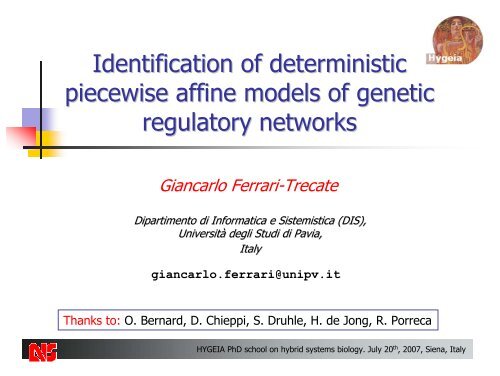
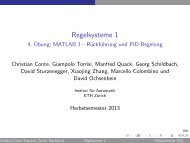
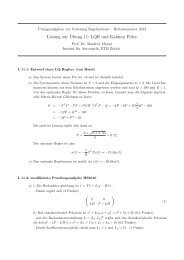

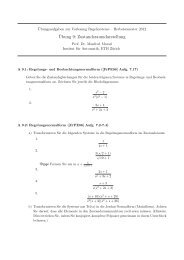
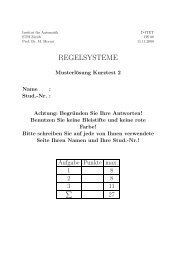

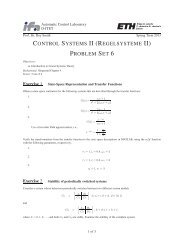
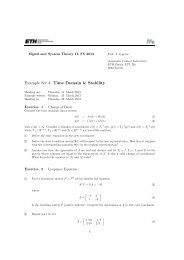

![Convex Optimization: [0.5ex] from Real-Time ... - ETH Zürich](https://img.yumpu.com/18678007/1/190x143/convex-optimization-05ex-from-real-time-eth-zurich.jpg?quality=85)
